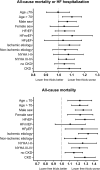Systemic oxidative stress associates with disease severity and outcome in patients with new-onset or worsening heart failure
- PMID: 36997667
- PMCID: PMC10062262
- DOI: 10.1007/s00392-023-02171-x
Systemic oxidative stress associates with disease severity and outcome in patients with new-onset or worsening heart failure
Abstract
Background: Oxidative stress may be a key pathophysiological mediator in the development and progression of heart failure (HF). The role of serum-free thiol concentrations, as a marker of systemic oxidative stress, in HF remains largely unknown.
Objective: The purpose of this study was to investigate associations between serum-free thiol concentrations and disease severity and clinical outcome in patients with new-onset or worsening HF.
Methods: Serum-free thiol concentrations were determined by colorimetric detection in 3802 patients from the BIOlogy Study to TAilored Treatment in Chronic Heart Failure (BIOSTAT-CHF). Associations between free thiol concentrations and clinical characteristics and outcomes, including all-cause mortality, cardiovascular mortality, and a composite of HF hospitalization and all-cause mortality during a 2-years follow-up, were reported.
Results: Lower serum-free thiol concentrations were associated with more advanced HF, as indicated by worse NYHA class, higher plasma NT-proBNP (P < 0.001 for both) and with higher rates of all-cause mortality (hazard ratio (HR) per standard deviation (SD) decrease in free thiols: 1.253, 95% confidence interval (CI): 1.171-1.341, P < 0.001), cardiovascular mortality (HR per SD: 1.182, 95% CI: 1.086-1.288, P < 0.001), and the composite outcome (HR per SD: 1.058, 95% CI: 1.001-1.118, P = 0.046).
Conclusions: In patients with new-onset or worsening HF, a lower serum-free thiol concentration, indicative of higher oxidative stress, is associated with increased HF severity and poorer prognosis. Our results do not prove causality, but our findings may be used as rationale for future (mechanistic) studies on serum-free thiol modulation in heart failure. Associations of serum-free thiol concentrations with heart failure severity and outcomes.
Keywords: Heart failure; Oxidative stress; Redox status; Sulfhydryl groups; Thiols.
© 2023. The Author(s).
Conflict of interest statement
S.D.A. reports receiving fees from Abbott, Actimed, Bayer, Boehringer Ingelheim, Cardiac Dimension, Cordio, Impulse Dynamics, Novartis, Occlutech, Servier, and Vifor Pharma, and grant support from Abbott and Vifor Pharma. The other authors declare that there is no relevant conflict of interest.
Figures


References
-
- Hage C, Löfgren L, Michopoulos F, Nilsson R, Davidsson P, Kumar C, et al. Metabolomic profile in patients with heart failure with preserved ejection fraction versus patients with heart failure with reduced ejection fraction. J Card Fail. 2020;26:1050–1059. doi: 10.1016/j.cardfail.2020.07.010. - DOI - PubMed
MeSH terms
Substances
Grants and funding
LinkOut - more resources
Full Text Sources
Medical
Research Materials
Miscellaneous

